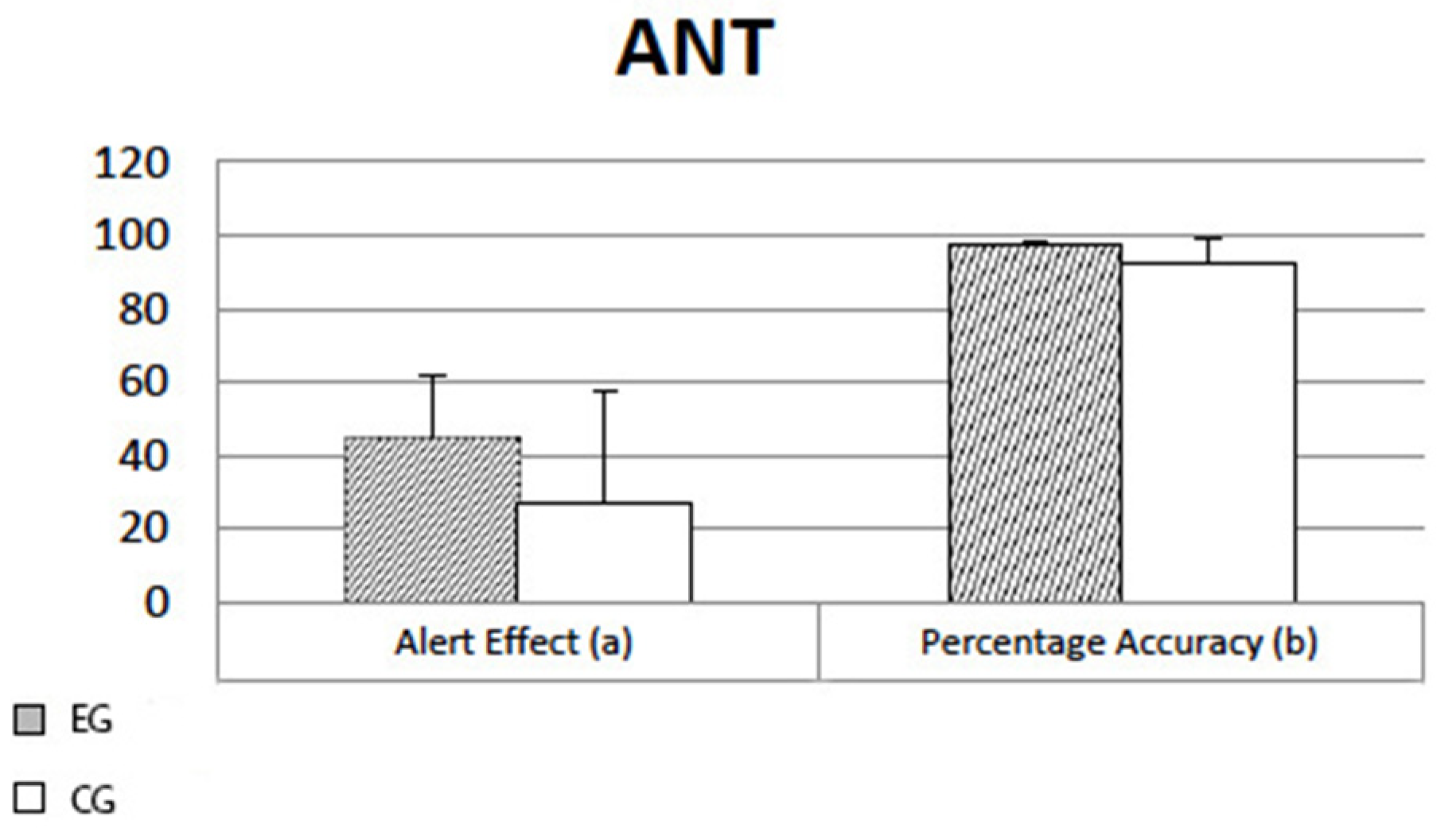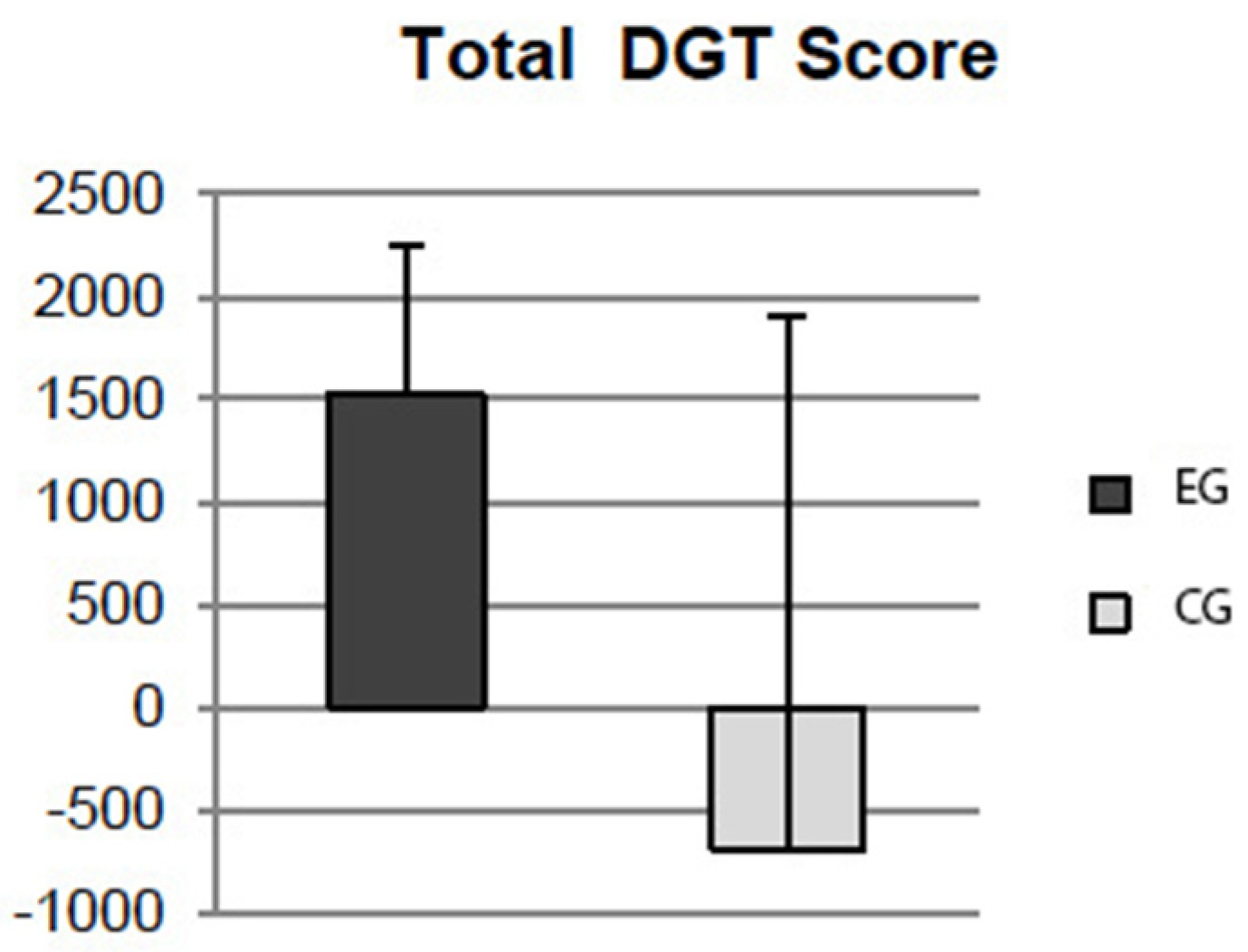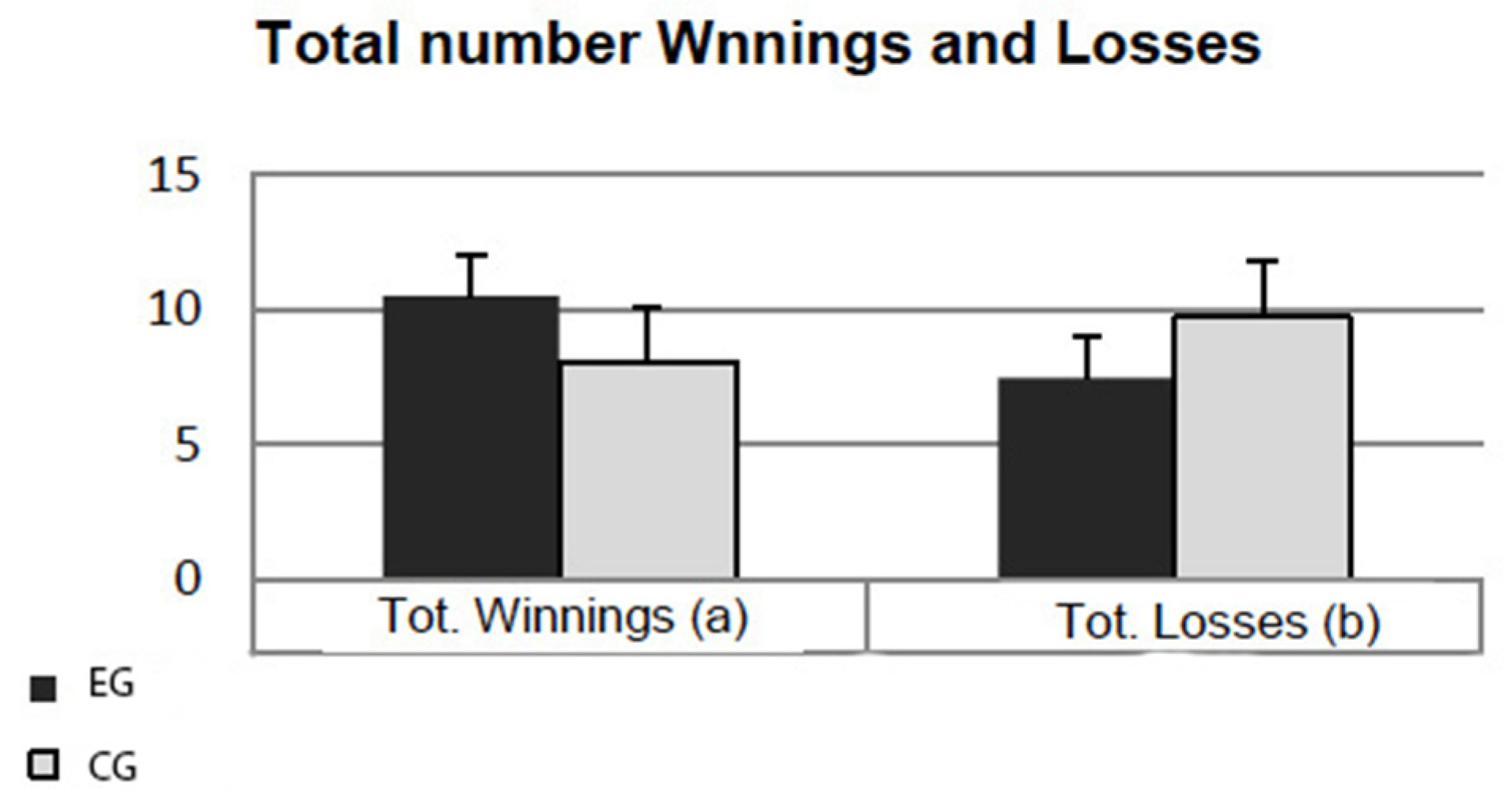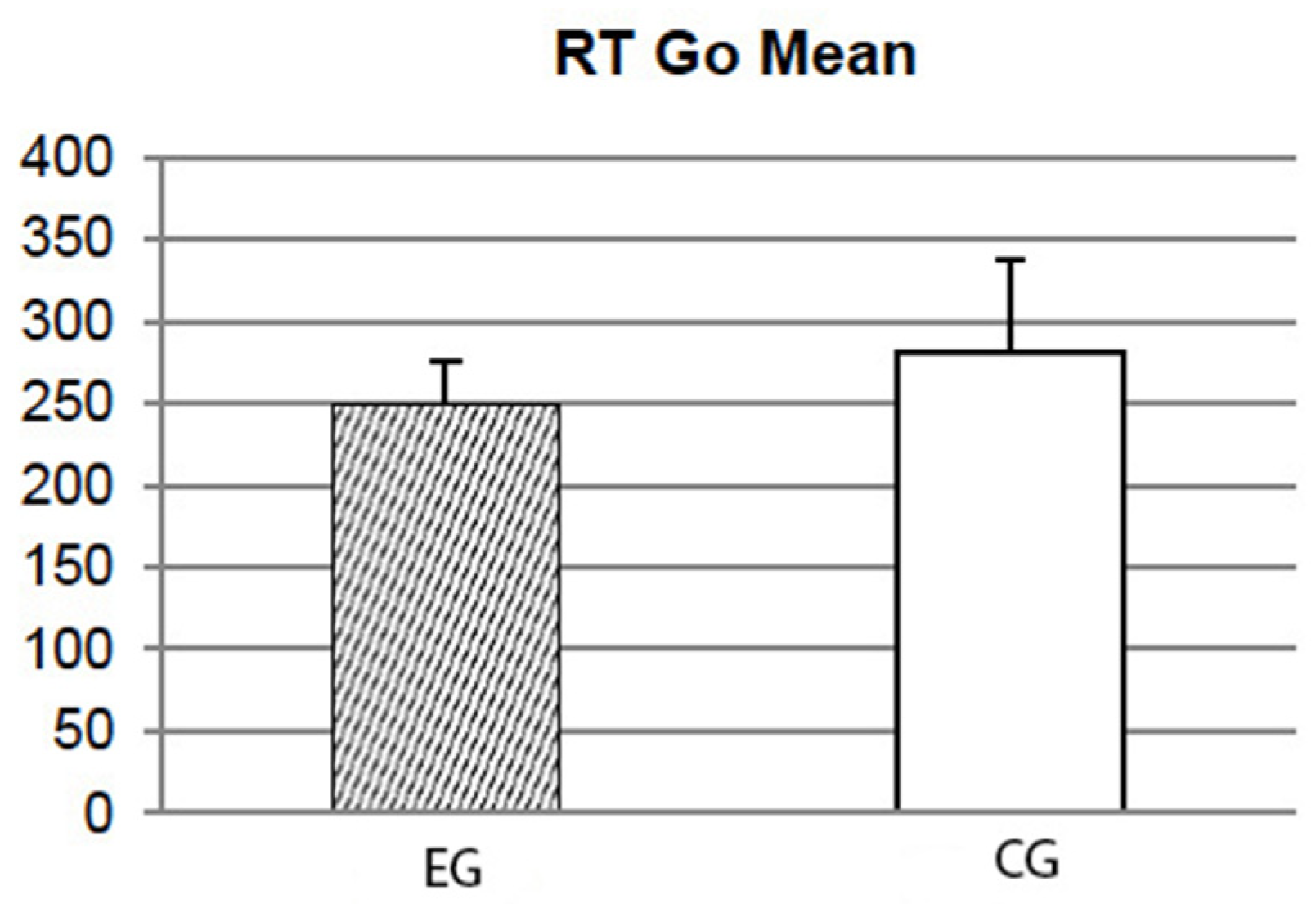Videogaming Frequency and Executive Skills in Young Adults
Abstract
:1. Introduction
2. Materials and Methods
2.1. Participants
2.2. Procedure
2.3. Tasks
2.4. Statistical Analysis
3. Results
3.1. Attention Network Task
3.2. Game of Dice Task
3.3. Go/NoGo
3.4. Task Switching Test
4. Discussion
Limitations to the Study and Future Directions
5. Conclusions
Author Contributions
Funding
Institutional Review Board Statement
Informed Consent Statement
Data Availability Statement
Conflicts of Interest
References
- Newzoo Global Games Market Report 2020. Key Trends. Market Sizing & Forecasts Special Focus Topics. Rankings. Available online: https://newzoo.com/insights/trend-reports/newzoo-global-games-market-report-2020-light-version/ (accessed on 30 June 2021).
- ESA. Essential Facts. Entertainment Software Assocation. 2020. Available online: https://www.theesa.com/wp-content/uploads/2020/07/Final-Edited-2020-ESA_Essential_facts.pdf (accessed on 7 February 2021).
- IDEA. Italian Interactive Digital Entertainment Association. I Videogiochi in Italia nel 2019. Dati sul Mercato e su Consumatori. 2020. Available online: https://iideassociation.com/notizie/in-primo-piano/iidea-presenta-il-nuovo-rapporto-annuale-sul-mercato-dei-videogiochi-in-italia.kl (accessed on 7 February 2021).
- Jones, C.M.; Scholes, L.; Johnson, D.; Katsikitis, M.; Carras, M.C. Gaming well: Links between videogames and flourishing mental health. Front. Psychol. 2014, 5, 260. [Google Scholar] [CrossRef]
- Zhang, Q.; Cao, Y.; Tian, J. Effects of Violent Video Games on Aggressive Cognition and Aggressive Behavior. Cyberpsychol. Behav. Soc Netw. 2021, 24, 5–10. [Google Scholar] [CrossRef] [PubMed]
- Poulain, T.; Vogel, M.; Buzek, T.; Genuneit, J.; Hiemisch, A.; Kiess, W. Reciprocal longitudinal associations between adolescents’ media consumption and sleep. Behav. Sleep. Med. 2018, 17, 763–777. [Google Scholar] [CrossRef]
- González-Bueso, V.; Santamaría, J.J.; Fernández, D.; Merino, L.; Montero, E.; Ribas, J. Association between internet gaming disorder or pathological video-game use and comorbid psychopathology: A comprehensive review. Int. J. Environ. Res. Public Health 2018, 15, 668. [Google Scholar] [CrossRef] [PubMed]
- Gentile, D. Pathological video-game use among youth ages 8 to 18. Psychol. Sci. 2009, 20, 594–602. [Google Scholar] [CrossRef] [PubMed]
- Boot, W.R.; Kramer, A.F.; Simons, D.J.; Fabiani, M.; Gratton, G. The effects of video game playing on attention, memory, and executive control. Acta Psychol. 2008, 129, 387–398. [Google Scholar] [CrossRef]
- Dye, M.W.G.; Green, C.S.; Bavelier, D. Increasing speed of processing with action video games. Curr. Direct. Psychol. Sci. 2009, 18, 321–326. [Google Scholar] [CrossRef] [PubMed]
- Irons, J.L.; Remington, R.W.; McLean, J.P. Not so fast: Rethinking the effects of action video games on attentional capacity. Austr. J. Psychol. 2011, 63, 224–231. [Google Scholar] [CrossRef]
- Murphy, K.; Spencer, A. Playing video games does not make for better visual attention skills. J. Artic. Support Null Hypothesis 2009, 6, 1–20. [Google Scholar]
- Dye, M.W.G.; Green, C.S.; Bavelier, D. The development of attention skills in action video game players. Neuropsychology 2009, 47, 1780–1789. [Google Scholar] [CrossRef]
- Wu, S.; Spence, I. Playing shooter and driving videogames improves top-down guidance in visual search. Attent. Percept. Psychophys. 2013, 75, 673–686. [Google Scholar] [CrossRef]
- Chisholm, J.D.; Hickey, C.; Theeuwes, J.; Kingstone, A. Reduced attentional capture in action video game players. Attent. Percept. Psychophys. 2010, 72, 667–671. [Google Scholar] [CrossRef]
- Donohue, S.E.; Woldorff, M.G.; Mitroff, S.R. Video game players show more precise multisensory temporal processing abilities. Attent. Percept. Psychophys. 2010, 72, 1120–1129. [Google Scholar] [CrossRef]
- Okagaki, L.; Frensch, P.A. Effects of video game playing on measures of spatial performance: Gender effects in late adolescence. J. Appl. Developm. Psychol. 1994, 15, 33–58. [Google Scholar] [CrossRef]
- Tsoi, L.; Koopman, S.; Wilmer, J.B. Video-game training improves smooth pursuit precision. J. Vis. 2011, 11, 527. [Google Scholar] [CrossRef]
- Clark, K.; Fleck, M.S.; Mitroff, S.R. Enhanced change detection performance reveals improved strategy use in avid action video game players. Acta Psychol. 2011, 136, 67–72. [Google Scholar] [CrossRef] [PubMed]
- Cain, M.S.; Prinzmetal, W.; Shimamura, A.P.; Landau, A.N. Improved control of exogenous attention in action video game players. Front. Psychol. 2014, 10, 69. [Google Scholar] [CrossRef] [PubMed]
- Wu, S.; Cheng, C.K.; Feng, J.; D’Angelo, L.; Alain, C.; Spence, I. Playing a first-person shooter video game induces neuroplastic change. J Cogn. Neurosci. 2012, 24, 1286–1293. [Google Scholar] [CrossRef]
- Bavelier, D.; Achtman, R.L.; Mania, M.; Föcker, J. Neural bases of selective attention in action video game players. Vis. Res. 2012, 61, 132–143. [Google Scholar] [CrossRef]
- Kühn, S.; Lorenz, R.; Banaschewski, T.; Barker, G.J.; Büchel, C.; Conrod, P.J.; Gallinat, J. Positive Association of Video Game Playing with Left Frontal Cortical Thickness in Adolescents. PLoS ONE 2014, 9, e91506. [Google Scholar] [CrossRef] [PubMed]
- Monsell, S. Task switching. Trends Cogn. Sci. 2003, 7, 134–140. [Google Scholar] [CrossRef]
- Colzato, L.S.; van Leeuwen, P.J.A.; van den Wildenberg, W.P.M.; Hommel, B. DOOM’d to switch: Superior cognitive flexibility in players of first-person shooter games. Front. Psychol. 2010, 1, 8. [Google Scholar] [CrossRef]
- Green, C.S.; Sugarman, M.A.; Medford, K.; Klobusicky, E.; Bavelier, D. The effect of action video game experience on task switching. Comp. Hum. Behav. 2012, 28, 984–994. [Google Scholar] [CrossRef]
- Bavelier, D.; Green, C.S. Enhancing attentional control: Lessons from action video games. Neuron 2019, 104, 147–163. [Google Scholar] [CrossRef]
- Toth, A.J.; Ramsbottom, N.; Kowal, M.; Campbell, M.J. Converging Evidence Supporting the Cognitive Link between Exercise and Esport Performance: A Dual Systematic Review. Brain Sci. 2020, 10, 859. [Google Scholar] [CrossRef]
- Dale, G.; Joessel, A.; Bavelier, D.; Green, C.S. A new look at the cognitive neuroscience of video game play. Ann. N. Y. Acad. Sci. 2020, 1464, 192–203. [Google Scholar] [CrossRef]
- Chopin, A.; Bediou, B.; Bavelier, D. Altering perception: The case of action video gaming. Curr. Opin. Psychol. 2019, 29, 168–173. [Google Scholar] [CrossRef]
- Ruiz-Marquez, E.; Prieto, A.; Mayas, J.; Toril, P.; Reales, J.M.; Ballesteros, S. Effects of Nonaction Videogames on Attention and Memory in Young Adults. Games Health J. 2019, 8, 414–422. [Google Scholar] [CrossRef]
- Small, G.W.; Lee, J.; Kaufman, A.; Jalil, J.; Siddarth, P.; Gaddipati, H.; Moody, T.D.; Bookheimer, S.Y. Brain health consequences of digital technology use. Dialogues Clin. Neurosci. 2020, 22, 179–187. [Google Scholar] [CrossRef]
- Fan, J.; McCandliss, B.D.; Sommer, T.; Raz, A.; Posner, M.I. Testing the Efficiency and Independence of Attentional Networks. J. Cogn. Neurosci. 2002, 14, 340–347. [Google Scholar] [CrossRef]
- Brand, M.; Greco, R.; Schuster, A.; Kalbe, E.; Fujiwara, E.; Markowitsch, H.J.; Kessler, J. The game of dice a new test for the assessment of risk-taking behavior. Neurorehab. Neural Repair 2002, 16, 142–143. [Google Scholar]
- Green, C.S.; Bavelier, D. Learning, attentional control and action video games. Curr. Biol. 2012, 22, R197–R206. [Google Scholar] [CrossRef] [PubMed] [Green Version]
- Donohue, S.E.; James, B.; Eslick, A.N.; Mitroff, S.R. Cognitive pitfall! Videogame players are not immune to dual-task costs. Atten. Percept. Psychophys. 2012, 74, 803–809. [Google Scholar] [CrossRef]
- Carrasco, M.; McElree, B. Covert attention accelerates the rate of visual information processing. Proc. Natl. Acad. Sci. USA 2001, 98, 5363–5367. [Google Scholar] [CrossRef]
- Appelbaum, L.G.; Cain, M.S.; Darling, E.F.; Mitroff, S.R. Action video game playing is associated with improved visual sensitivity, but not alterations in visual sensory memory. Attent. Percept. Psychophys. 2013, 75, 1161–1167. [Google Scholar] [CrossRef] [PubMed]
- Persuh, M.; Genzer, B.; Melara, R.D. Iconic memory requires attention. Front. Hum. Neurosci. 2012, 6, 126. [Google Scholar] [CrossRef]
- Schubert, T.; Strobach, T. Video game experience and optimized executive control skills on false positives and false negatives: Reply to Boot and Simons (2012). Acta Psychol. 2012, 141, 278–280. [Google Scholar] [CrossRef]
- Wilms, I.L.; Petersen, A.; Vangkilde, S. Intensive video gaming improves encoding speed to visual short-term memory in young male adults. Acta Psychol. 2013, 142, 108–118. [Google Scholar] [CrossRef]
- Leigh, B.C. Peril, chance, adventure: Concepts of risk, alcohol use and risky behavior in young adults. Addiction 1999, 94, 371–383. [Google Scholar] [CrossRef]
- Jordan, T.; Dhamala, M. Enhanced dorsal attention network to salience network interaction in video gamers during sensorimotor decision-making tasks. Brain Connect, 2022; online ahead of print. [Google Scholar] [CrossRef]
- Hartanto, A.; Toh, W.X.; Yang, H. Age matters: The effect of onset age of video game play on task-switching abilities. Atten. Percept. Psychophys. 2016, 78, 1125–1136. [Google Scholar] [CrossRef] [PubMed]
- Unsworth, N.; Redick, T.S.; McMillan, B.D.; Hambrick, D.Z.; Kane, M.J.; Engle, R.W. Is playing video games related to cognitive abilities? Psychol. Sci. 2015, 26, 759–774. [Google Scholar] [CrossRef] [Green Version]
- Wu, X.; Jiang, Y.; Jiang, Y.; Chen, G.; Chen, Y.; Bai, X. The influence of action video games on attentional functions across visual and auditory modalities. Front. Psychol. 2021, 12, 611778. [Google Scholar] [CrossRef]
- Latham, A.J.; Patston, L.L.M.; Tippett, L.J. Just how expert are “expert” video-game play-ers? Assessing the experience and expertise of video-game players across “action” video-game genres. Front. Psychol. 2013, 4, 941. [Google Scholar] [CrossRef]
- Boot, W.R.; Blakely, D.P.; Simons, D.J. Do action video games improve perception and cognition? Front. Psychol. 2011, 2, 226. [Google Scholar] [CrossRef]
- Kristjánsson, Á. The case for causal influences of action video game play upon vision and attention. Attent. Percept. Psychophys. 2013, 75, 667–672. [Google Scholar] [CrossRef] [PubMed]
- Franceschini, S.; Gori, S.; Ruffino, M.; Viola, S.; Molteni, M.; Facoetti, A. Action video games make dyslexic children read better. Curr. Biol. 2013, 23, 462–466. [Google Scholar] [CrossRef] [PubMed]
- Green, C.S.; Bavelier, D. Effects of action video game playing on the spatial distribution of visual selective attention. J. Exp. Psychol. Hum. Percept. Perform. 2006, 32, 1465–1478. [Google Scholar] [CrossRef] [PubMed]
- Green, C.S.; Bavelier, D. Enumeration versus multiple object tracking: The case of action video game players. Cognition 2006, 101, 217–245. [Google Scholar] [CrossRef]
- Li, R.; Polat, U.; Makous, W.; Bavelier, D. Enhanching the contrast sensitivity function through action video game training. Nat. Neurosci. 2009, 12, 549–551. [Google Scholar] [CrossRef] [PubMed]
- Li, R.; Polat, U.; Scalzo, F.; Bavelier, D. Reducing backward masking through action game training. J. Vis. 2010, 10, 33. [Google Scholar] [CrossRef] [PubMed]
- Oei, A.C.; Patterson, M.D. Enhancing cognition with video games: A multiple game training study. PLoS ONE 2013, 8, e58546. [Google Scholar] [CrossRef] [PubMed] [Green Version]




Publisher’s Note: MDPI stays neutral with regard to jurisdictional claims in published maps and institutional affiliations. |
© 2022 by the authors. Licensee MDPI, Basel, Switzerland. This article is an open access article distributed under the terms and conditions of the Creative Commons Attribution (CC BY) license (https://creativecommons.org/licenses/by/4.0/).
Share and Cite
Peracchia, S.; D’Aurizio, G.; Curcio, G. Videogaming Frequency and Executive Skills in Young Adults. Int. J. Environ. Res. Public Health 2022, 19, 12081. https://doi.org/10.3390/ijerph191912081
Peracchia S, D’Aurizio G, Curcio G. Videogaming Frequency and Executive Skills in Young Adults. International Journal of Environmental Research and Public Health. 2022; 19(19):12081. https://doi.org/10.3390/ijerph191912081
Chicago/Turabian StylePeracchia, Sara, Giulia D’Aurizio, and Giuseppe Curcio. 2022. "Videogaming Frequency and Executive Skills in Young Adults" International Journal of Environmental Research and Public Health 19, no. 19: 12081. https://doi.org/10.3390/ijerph191912081
APA StylePeracchia, S., D’Aurizio, G., & Curcio, G. (2022). Videogaming Frequency and Executive Skills in Young Adults. International Journal of Environmental Research and Public Health, 19(19), 12081. https://doi.org/10.3390/ijerph191912081







